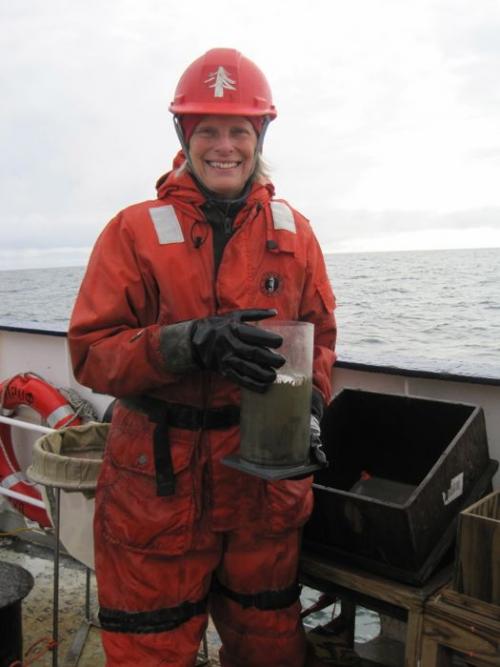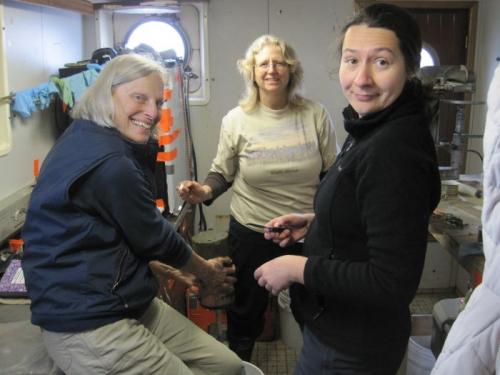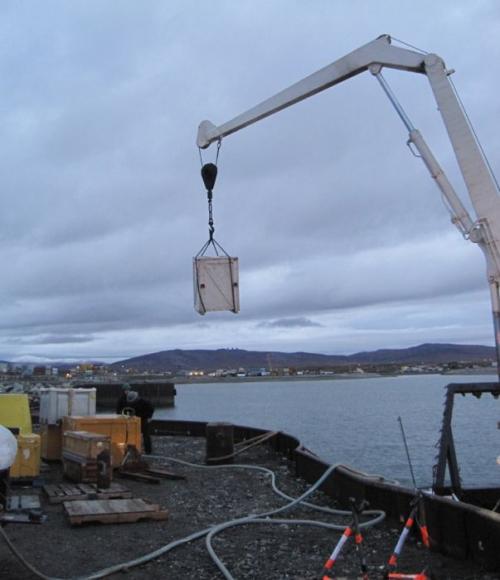I'm writing this a day early because tomorrow will be pretty crazy and shipboard email connections shut down tonight. We're taking a slightly round about way to Nome via the Siberian coast. Kate (mammals) and Declan (birds) missed their opportunity to survey here because we were close to the coast over night the last time. Once we picked up a few hours, they were very happy to hear that we'd be headed back this way on our way "home" to Nome. We'll be arriving in Nome on the 16th in the early morning and will be at the dock by noon. Jackie and I have already started packing, labeling and inventorying equipment, gear, and samples, and we've been rinsing everything in fresh water. Once they turn on the fresh water hose on deck, we'll rinse 2.5 weeks of mud off our mustang suits. They've been hosed down with salt water on occasion, but it's just not the same.

Throughout the day containers came out of the hold, labs were slowly emptied, and the aft deck became cluttered. Talk on board centered on shipping – cost, which company, by barge, air or land, etc. While many of us were worrying about keeping our personal gear less than 50 pounds, others were talking about shipments up to a few thousand pounds. Once we dock, the winches on board will begin to work continuously, slinging gear off the ship where it will then be taken to cargo transport. The four who are heading for their next cruise will fly out in the evening, while others, including Jackie, Monika and me will stay on board and leave on Monday. I have a morning flight, but Jackie and Monika will stay to make certain all the cargo is transported to the carrier and ready to go back to Solomons, MD to the Chesapeake Biological Lab.

It's been an interesting and exciting cruise. After an extremely rough start due to weather, where we aborted several stations, we've since completed nearly 70 stations, working in both US and Russian waters. We were in ice for several days, and we´ve passed gray, humpback, and bowhead whales, ringed, bearded, ribbon, and spotted seals, walrus, polar bears and numerous Arctic birds. Those sampling the various stations will bring back countless samples to be analyzed and processed once they return to their labs/research institutions in Russia, the US, Korea, and even Bermuda. What a privilege it has been for me, a retired high school science teacher, to be a part of both the 2009 and 2012 RUSALCA cruises. My other "job" on board, posting journals and photographs, gave me the opportunity to talk with members of each of the science teams. It has been a great learning experience for me, talking with them and watching them work. There is much yet to be discovered and so much scientists still don´t understand about this part of the Arctic, but each cruise adds data to help scientists unravel the complexities of this system. The fish, the sediments, the water masses, the zooplankton, the benthic organisms, the mammals and the birds - all have stories to tell. There are so many on board who deserve thanks. First of all, thanks go to all of the incredibly busy members of the science teams who found time to talk with me and share their work. Thanks also to Alexsey Ostrovskiy, Group Alliance Representative, who was kind enough to help with translation when I spoke with some of the Russian scientists. A special thanks goes out to the scientific support team, the men who worked the winches and/or were on deck during all operations, day and night, in all weather. They are Sergey Yarosh and Iouri Pashchenko. I must also thank Marieke Egan from Heritage Expeditions, who has kindly found time to post my journals.

For additional pictures of the work on board and more detailed information about individual scientists, remember to check out the NOAA site, www.oceanexplorer.noaa.gov/explorations/12arctic/welcome/htmlwhere you'll find journals posted by Kate Stafford. Last, but by no means least, a great big thank you goes to Dr. Jackie Grebmeier who has invited my to travel with her, work with her, and share her boundless excitement about the Arctic for 8 cruises since 2002 (Jackie estimates that she's been out on at least 60 cruises since her first one in 1984!). While still teaching, my students were a part of my amazing experience and now that I´m retired, I hope that my journals will continue to help others understand and appreciate how science is done on board a research cruise, and to learn more of what is happening, biologically, geologically, physically, and chemically, in this unique part of the world. I´ve posted a couple of pictures of myself with this journal because friends and relatives often remind me that they don´t see me in any of my photographs.
Note (added September 19): Things got a bit crazy at the end of the cruise when the ship could not get into the harbor due to low waster. The high winds had pulled enough water out that it was actually too shallow for the ship. People changed flights and those who were scheduled for an earning flight were set to go ashore by the pilot boat. As they waited in all of their floatation gear, to climb down the Jacob's ladder over the side, the boat pulled along side and then turned off and returned to shore. The captain had just received word that the ship could go in. Because it was uncertain how long it would stay at the dock, everything was off loaded that night, and people prepared to leave the ship at any time. It worked out that I caught my flight in the morning while Jackie and Monika had to stay behind to deal with all 31 pieces of our cargo.
- < prev
- 20 of 20


Comments